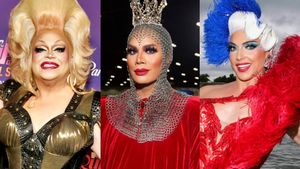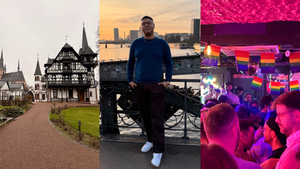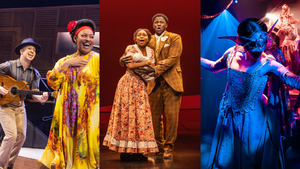A recent wave of violence, including murders in New York City and Washington, D.C., puts an urgent focus on the predicament faced by many transgender women of color.
Earlier this month, advocates, friends, and elected officials gathered in East Harlem to mourn Camila Guzman, a transgender woman found stabbed to death in her apartment August 1. Sad and defiant, with personal tributes and chants of "queremos justicia" ("we want justice"), the evening marked the latest somber recognition for a transgender victim. It also delivered a potent reminder of the multilayered discrimination transgender women of color face because of their race, gender identity, and related factors.
"It boils down to the intersection of prejudices," said Melissa Sandel, an HIV prevention specialist for the Community Healthcare Network's transgender family program, who attended the vigil. "It's hard, period."
According to a report from the National Coalition of Anti-Violence Programs released in July, transgender women of color experienced hate violence far disproportionate to their actual numbers in the lesbian, gay, bisexual, transgender, queer, and HIV-affected community. People of color represented 70% of all LGBT-bias-related murder victims in 2010, and some 44% of LGBT murder victims were transgender women.
Similar trends have been observed in 2009 and in previous years, but now, as more sensitive portrayals of transgender women emerge in films like Gun Hill Road and marriage equality advocates celebrate victory in New York, the violence provides a jarring comparison of how far many transgender women of color still have to travel for safety and acceptance.
"There's a lot more attention and public knowledge," said Chai Jindasurat, NCAVP Coordinator at the New York City Anti-Violence Project. "We're seeing reporting happening more because our communities are becoming visible, specifically around this violence against transgender women of color. But I think a lot of this is just the tip of the iceberg."
In July, Lashai McLean, 23, was shot to death in northeast D.C. Her circumstances differ in some ways from Guzman's, but together the cases illustrate some of the most intractable hurdles faced by transgender women of color, particularly as they relate to law enforcement and media.
Following her murder July 20, police in D.C. identified McLean with her male birth name and circulated a mug shot from a prior arrest. Outraged advocates met with police chief Cathy Lanier last week to discuss the possibility of new reporting protocols and to express related concerns about an attempted shooting of another transgender woman, Tonya Harrell, in the same neighborhood just 11 days later. Combined with an attack on five lesbians at the Columbia Heights metro station that police initially refused to report last month, the incidents have raised questions about the restructuring of the police department's Gay and Lesbian Liaison Unit undertaken two years ago.
"I think our overall issues right now are with the police and how they are handling everything," said Brian Watson, director of programs for Transgender Health Empowerment, where McLean frequented a drop-in center. "We seem to be having issues with how police handle crime as they relate to the LGBT issues."
Guzman, who was 38, was identified by the wrong gender in at least two local New York media reports. In the most controversial example, the New York Post used male pronouns and referred to her as a "hooker," which prompted advocates to issue a news release demanding more respectful reporting. The botched reporting of gender and presumption of prostitution for transgender women of color reflects patterns monitored by watchdog groups including the Gay and Lesbian Alliance Against Defamation.
Whether or not victims engage in sex work, advocates say the activity represents a choice of last resort and attests to the discrimination that transgender women of color experience in the job hunt. Many lack educational credentials, having left school before graduation because of bullying or rejection from home.
"A lot of them cannot find employment. It's survival sex," said Watson. "When it comes to the stigma, bottom line, we see so many young ladies who do engage in prostitution because they have no other option."
While McLean was a native of the D.C. area, Guzman was an immigrant from Chile who came to the United States almost a decade ago hoping to live openly as a transgender woman. Immigrants can encounter additional hurdles in documentation matters (like an inability to change gender designations on identification cards and birth certificates), which complicate their efforts to find work and generate calls for broader changes.
"I want President Obama to listen to us so politicians give asylum to transgender immigrants of color who face incredible violence in our home countries," said Ruby Chavez, a friend of Guzman's, at the vigil outside her East Harlem apartment. "We are humans."
Last week police arrested Equan Southall, Guzman's boyfriend, after he walked into an East Harlem precinct station and reportedly confessed to killing her. No arrest has been made in McLean's death, one of at least six open transgender homicide cases in the D.C. area from the past 11 years. Each year on International Transgender Day of Remembrance, legions of murdered transgender individuals are memorialized -- most of them women -- and many of their homicides are never solved.
"The transgender community has not been provided any justice," said Jeri Hughes, an administrative assistant at Transgender Health Empowerment, who knew McLean. "Enough is enough. We're tired of burying our women."




































































Charlie Kirk DID say stoning gay people was the 'perfect law' — and these other heinous quotes